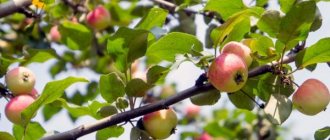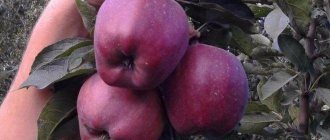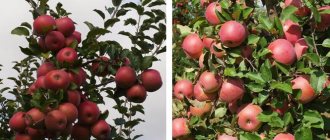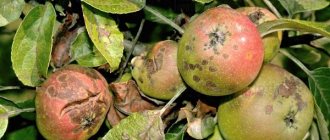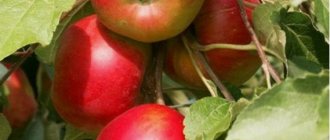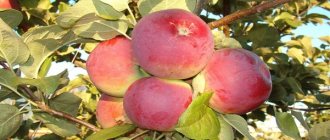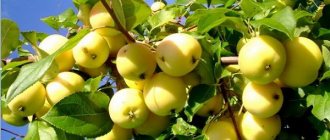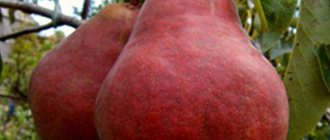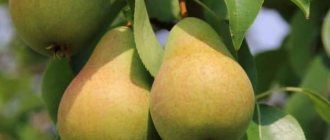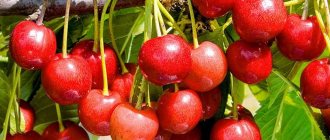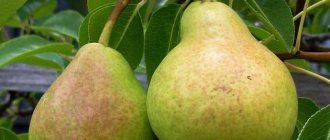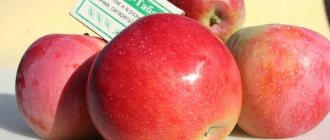It is with great pleasure that I get acquainted with numerous publications about the apple tree. It's interesting when points of view are different. And when experts share their correct approaches. And amateur gardeners - with their experience.
After all, the purposes of planting apple trees are different . But there are also common points.
Everyone likes:
- Beautiful, large and tasty fruits;
- Abundant and annual harvests;
- So that you don’t get sick and pests don’t eat;
- So that they can be stored longer (well, I really want to eat my apples on March 8);
- I don’t really want to plant tall-growing ones: Then try to process and remove tall-growing apples. And at the top they are always the best.
What kind of garden should I grow? Traditional approach - 5-8 apple trees on vigorous rootstocks:
- A couple of summer ones;
- 1-2 autumn;
- 3-5 winter.
But there are many innovators. And they think that dwarf is a level. And the same area will allow you to plant 10-15 apple trees:
- 2-3 year olds;
- 2-3 autumn;
- 6-9 winter.
Advice! With all options, you will be recommended to plant the Orlovim variety.
Apple tree Orlovim
In this section we will present you with a photo and description of the variety . Meet:
- Year of birth 1977;
- Created by the All-Russian Research Institute;
- Included in the State Register of Selection Achievements for the Central Region of Russia in 1989;
- Antonovka vulgare in parents;
- So far he has no relatives. There is a slight resemblance to Melba.
Apple tree Orlovim.
And now about the tree itself:
- A medium- sized, round tree. Branches of different lengths are spaced sparsely. Sometimes they move away from the trunk at an angle of 90 degrees;
Important! You won’t see it high – no more than 5 m;
- The root system is powerful: both horizontal and vertical roots (even over 4 m).
- Fruits - on average 120-140 g . There are also more than 150 g, and even 180 g. Flat-elongated shape. Most often with uneven sides. Red stripes are striking. And the blush is a little blurry. The surface of the fruit has slight ridges;
- The color of the pulp is cream;
- The taste is sweet with sourness and a characteristic aroma, slightly reminiscent of Antonovka. The creamy flesh is soft and very juicy. The skin is oily and thin. And there is enough sugar;
- Ripening from the second half of August . You will often be able to consume them until the end of September.
additional characteristics
Advantages and disadvantages
So, what kind of apple tree is Orlovim? Like any other variety, it has its pros and cons.
Why you might like it:
- Immunity to scab;
- Frost resistance at the highest level;
- Begins to bear fruit early;
- The yield is fine;
- The appearance is quite marketable;
- Good taste.
Orlovim is immune to scab.
Disadvantages or features to consider:
- You won't be able to store them for a long time. About a month, they are not winter;
- The height is still decent, which makes caring for them more difficult;
- Immunity to scab weakens with age.
Advice! Trees of this variety do not need protection from frost. But be sure to wrap it up against rodents. And also whiten it in winter.
Tree height
- No more than 5 m on a vigorous rootstock;
- Mostly medium height;
- With good growth rates.
Crown width
- The shape is round, spherical;
- Medium density and up to 6 m in diameter.
Krona Orlovim.
Productivity
- Abundantly and annually;
- With good care, you can harvest up to 100 kg . From a 9-12 year old tree.
Self-pollinating
- What this variety does not have is the ability to self-pollinate. But solve this problem by planting other varieties nearby: late summer varieties are especially suitable. If you don’t like this name, call it early autumn.
Tasting assessment
We are all different in taste and color. Anyone who has been watching figure skating for a long time continues to be amazed at the grading system. Specialists are high-class judges, but their assessments are different.
So it is with Orlov:
- For taste - 4.4-4.6 points;
- For artistry (appearance) – 4.3.
Winter hardiness
Only positive reviews. To say that it endures winter well is simply an understatement. severe winters with temperatures below 30 degrees in the air and up to 35 on the surface without damage. Unlike Melba.
Disease resistance
This variety not only exhibits high disease resistance. He is immune to such a dangerous disease as scab. He was raised that way. And the four scab races (all that exist in Russia) are not afraid of him. This is on vigorous rootstocks.
Seedling care
After planting an apple tree, the gardener’s task will be to create a powerful and strong skeleton of the tree with the correct arrangement of branches. Before fruiting begins, it is necessary to provide care for the trunk circle and row spacing.
See also
Description and subspecies of the Antonovka apple tree variety, planting and care rules
Read
Watering
During a dry summer, the yield of the Orlovim apple tree will depend on the provision of moisture to the crop. In the first year after planting it is necessary to water 5-6 times, and in subsequent years 4 times are sufficient. They begin to moisten the root circle in the spring, then twice in June, once in July and in the fall. The soil needs to be wetted to a depth of 50 centimeters, so pour 5-7 buckets of water onto each tree trunk circle.
Top dressing
During the summer period, fertilizing is applied to the tree trunk circle. If the apple trees have begun to bear fruit, then you need up to 2-3 kilograms of manure per square meter of land, 30-50 grams of superphosphate, and 12-15 grams of potassium salt and ammonium nitrate are enough. They are fed with manure and potassium phosphate fertilizers in the fall, and before spring cultivation with ammonium nitrate. It is best to dilute tukki in a bucket of water and water them in furrows located 1.5 meters from the trees.
To form fruits, you need phosphorus-potassium fertilizers: 20 grams of superphosphate and 10 grams of potassium salt per bucket of water. This is enough for 2-3 linear meters of furrow.
Crown formation
Pruning an apple tree can increase yield. By thinning the crown, they help the apples receive more light and air, which helps them fill faster. It is necessary to trim those branches that grow parallel or inside the crown.
Dried, diseased branches are removed regularly in spring and autumn.
Seasonal processing
It is necessary to shorten the skeletal branches by a third a year after planting. When the tree begins to bear fruit, emphasis is placed on sanitary pruning.
Wintering and mulching
Young trees of the Orlovim variety are tied with matting or reeds in late autumn. You need to mulch the soil around the apple tree with sawdust or humus. The mulch layer is 20 centimeters.
Reviews
Anna Anatolyevna. The Orlovim apple tree variety is a great find for beginning gardeners. No special care is required. Frost resistance is high. I would especially like to note that it is absolutely resistant to scab. And to other diseases, more or less... Among summer apples, it is perhaps the best. Even though it's late summer. The taste is very pleasant and juicy. It’s not even comparable to Melba – in size and taste. Yes, and in terms of safety.
Igor Petrovich. If I were to start a garden now... I would definitely plant a couple of summer varieties, Orlovim. This is a godsend for a gardener. The white filling is receding... And there’s more hassle with it. Even more so for Yaroslavl. Got vaccinated. The very next year they bloomed profusely. The ovary was regulated. And the apples grew massive (up to 300 g!). Juicy, with pleasant pulp. Although they seemed a bit sour. Maybe it rains... It bears fruit every year and does well. And scab is not terrible.
Anatoly. A lot is written about new varieties of apple trees. And the Orlovim variety is often mentioned. At first I thought it was a spelling mistake. Maybe Orlov? Or maybe Orlov? I don’t know for sure. But I know for sure that this variety deserves to be grown in your garden. Resistant to scab and frost. It bears fruit every year and quite well. I recommend!
Advantages and disadvantages
The prevalence of the variety in gardens is due to the fact that the Orlovim apple tree:
- withstands low temperatures in winter;
- bears fruit annually and soon;
- famous for its tasty and juicy fruits;
- Scab resistant.
Ripening in August-September, apples do not spoil and are stored for a month. But they make delicious preparations for the winter.
Among the disadvantages of this variety is that the tree’s high height makes it difficult to care for.
Features of planting and care
Landing
Deadlines
Like many other apple trees, plant them taking into account local conditions and weather conditions:
- In spring from the end of April. And in the first half of May;
- In autumn, planting is more successful in the southern regions.
Watch the video on how to properly plant an apple tree in spring:
And a video on how best to plant an apple tree in the fall:
Attention! Be sure to consider the time for rooting seedlings. And they need 25-30 days before frost.
Technology
- Choose a place in the sun . The variety is very responsive to full lighting and good ventilation. As they say, he is not used to remaining in the shadows;
- Don't forget to take into account the groundwater level. It loves watering, but the planting site should not be a place for collecting water;
- The soil is more suitable loamy and sandy loam . Acidity – 5.6-6.0 pH.
Apple tree planting diagram.
Experts advise doing everything sedately and thoroughly:
- Prepare the planting hole ahead of time: Dig it 3-4 weeks before planting (width -50-70 cm, depth - up to a meter);
- Fill with compost, humus, ash, mineral fertilizers (superphosphate, nitroamophoska, urea).
- Each row is 3 meters apart, and between the rows is about 5 meters.
Important! The earth will definitely shrink. Therefore, make sure that the root collar is at a distance of about 7-10 cm from the ground level.
Growing
- Features determine its merits;
- And don’t forget that Orlovim is a scab-immune variety. And this gives you the opportunity not to use chemistry for this common disease.
And further:
- Carry out a set of measures against pests at the beginning of the growing season.
Agricultural technology
Traditional. Everyone plans:
- When to prune and what kind;
- Measures to protect against pests and diseases (whitewashing trunks, spraying with fungicides and insecticides);
- Watering (several abundant waterings per season depending on weather conditions);
- Top dressing (both root when digging tree trunk circles, and foliar when spraying);
- Loosening and mulching.
Water the apple tree depending on the weather.
If you have experience growing apple trees, and not just eating them, you will have fewer problems with this variety.
Crown formation
What appearance the crown of your apple tree will take depends on you:
- But the sparse-tiered variety is more suitable for this variety;
- True, the spindle-shaped one also looks very nice;
- You can surprise your friends with a whole row near your house. In the form of a palmette.
Sparsely tiered crown.
Note to self:
- Give the whole tree a year to grow freely;
- Control the sharpness of the skeletal branches from the trunk. To prevent breaks.
Watch the video on how to properly form the crown of an apple tree:
How to prune a young apple tree?
Having decided on the form, you will be able to lay down future harvests from a young age. Apply green operations:
- Pinch and break off carefully;
- Shorten the side branches extending from the trunk at an angle of about 90 degrees by only 3-4 cm: And do not touch the central conductor.
Remember!
- Pinch on the outer bud;
- Perform pruning before sap flow begins in the spring.
Planting seedlings
When choosing a place for a seedling of the Orlovim variety, special attention should be paid to the level of illumination of the area. It is this indicator that affects the yield and taste of Orlovim fruits.
Since this variety does not tolerate highly moist soils, seedlings are planted on hills or a good drainage layer is provided. The optimal soil option for the Orlovim variety is chernozem, loamy or sandy loam soil.
Soil preparation
To ensure that the seedling takes root easily, the planting hole is prepared in advance. Suitable pit parameters: diameter 0.6-0.8 m, depth - 0.5-0.6 m. Moreover, it is advisable to stack the fertile and lower layers of soil separately.
A small layer of drainage is laid at the bottom of the hole (especially important if the groundwater is shallow). First fill up the top fertile layer of soil. The remaining soil is thoroughly mixed with humus, compost, ash and mineral fertilizer are added.
Planting stages:
- The root of the Orlovim variety seedling is carefully examined. Sections should be white. If there is a brown tint, it means the root has been damaged and needs to be shortened a little using pruners or a knife.
- First, drive a stake into the center of the hole - this will be a support for the seedling. Then the tree is lowered into the hole and the roots are carefully straightened.
- The hole is filled with a fertile mixture. The soil around the Orlovim variety seedling is compacted.
- A small depression in the form of a ditch is made around the circumference of the pit. Thanks to this, moisture will be absorbed in the right place.
- The surface of the ground around the seedling is watered and mulched with sawdust or peat.
Important! The root collar of the Orlovim apple tree should be above ground level.
Features of ripening and fruiting
Beginning of fruiting
- You can see apples already in the 3rd year after planting . Admire and expect full harvests;
- And, of course, try it.
Pollinator varieties
Apple trees of the Orlovim variety are self-sterile. they need neighbors as pollinators It could be:
- Pepin saffron;
- Welsey;
- Scarlet anise.
Pepin saffron.
Welsey.
Scarlet anise.
Do not rush to be upset if these varieties are not available. And many others are coming.
Important! Experts also use artificial pollination. Then there will be more apples. And they are bigger.
Deadlines
Blooms
The blossoming of the apple tree leaves no one indifferent. This happens in the first half of May.
Don't miss the opportunity to visit the garden when the apple trees are in bloom. Smell the flowers and listen to the buzzing bees!
Flowering Orlovim.
Fruit ripening
The fruits do not all ripen at once. And this happens:
- From the second half of August - removable maturity (still a little greenish color );
- Until mid-September – consumer maturity ( light yellow color of apples).
Fruit storage
Your task is to properly use the opportunities provided to process these valuable apples. They remain in good temperature conditions for up to a month.
Here you go:
- Juices;
- Jams;
- Jam;
- Confitures.
Fruiting
The variety deserves special attention:
- Rapid entry into fruiting;
- High productivity;
- And it makes me happy every year.
Characteristics and description of the variety
Before planting an apple tree, it is necessary to determine a place for the tree on the site. Therefore, it is necessary to know what the plant will be like after several years of growing season.
Tree size
The height of the Orlovim apple tree can reach from 4 to 5 meters. It all depends on what rootstock the seedling was grafted onto. And the diameter of the spherical crown of a garden tree is considerable - about 6 meters.
But when pruning, you can reduce the size of the apple tree to make it easier to care for.
Root system
The root system of the apple tree consists of skeletal, fibrous and suction roots. The skeleton of the tree's underground system is formed from the skeletal ones. Vertical and horizontal roots are located at a depth of 4 meters and below. On top are fibrous roots, highly branched. At the ends there are small white hairs up to 4 millimeters long. They absorb nutrients from the soil. Between the trunk and the root system there is a root collar, which is used to determine the planting depth of the apple tree.
Fruiting
The speed at which the fruiting period begins is important for varietal apple trees. The Orlovim variety produces apples in the 3-4th year of the tree’s life.
Flowering and pollinators
The apple tree is covered with white and pink flowers in May and early June. Then the fruits begin to set, forming until the end of summer - beginning of autumn. But since the Orlovim variety is self-sterile, pollinator trees are needed nearby. They are planted at a distance of 5-6 meters from each other. Apple tree varieties with late summer ripening are selected for pollination. The best would be Anis Scarlet, Wells.
Apple ripening and harvesting dates
On average, fruits on varietal apple trees ripen at the end of August. They are collected gradually as they become ripe. Collect carefully so that apples do not fall on a hard surface. If hit hard, the fruit will split open.
Productivity
The advantages of the Orlovim variety include its early ripening and high yield. After 9 years of growth, the apple tree produces up to 80 kilograms of fruit. And up to 100 kilograms of apples are harvested from an adult tree. Average yields are defined as 200 centners per hectare.
Taste and scope of application
The weight of one apple of this variety reaches 120-170 grams. Apple tree fruits:
- greenish color during harvesting and yellowish during consumption;
- with creamy pulp of dense texture;
- sweet and sour taste and strong aroma, reminiscent of Antonovka;
- contain 10.2% sugar, 10.2 mg/100 g ascorbic acid.
See also
Description of the dwarf apple tree variety Grounded, planting and care
Read
The external fruit of apples is rated 4.3 points, and the taste is 4.5.
Apples can be kept fresh for a month. Therefore, they are used to prepare jams, preserves, compotes, and juices.
Resistance to diseases and pests
The Orlovim variety has high resistance of leaves and fruits to scab. Occasionally, apple trees can get sick with other fungal infections and be attacked by pests if their care is poorly organized.
Low temperature resistance
Apple trees of this variety are not susceptible to frost. It was noticed that at a temperature of 35 degrees below zero, no damage was noticed on the tree.
Subspecies and options
On a dwarf rootstock
Apple trees grafted onto vegetatively propagated low-growing rootstocks are usually called:
- Dwarfs - on Paradise;
- Semi-dwarf - on Dusen.
They are good:
- They begin to bear fruit earlier – already in the second year;
- It is more convenient to care for them;
- You can plant even with high groundwater;
- You can plant more varieties in the same area.
But don't forget! The value of the developed Orlovim variety lies in its exceptional frost resistance and the possibility of planting in regions with harsh climates.
And again, your wishes and desires will put everything in its place.
Summer and late summer
There are different names for the ripening periods of the Orlovim apple tree - late summer and early autumn. Even autumn. And they are true. Ultimately what matters is:
- Ripens in late summer;
- We collect and use in early autumn;
- And there are also different regions. So let's plant and enjoy the wonderful fruits. And late in summer and early in autumn.
Growing in different regions
In Siberia
Scientists saw the task of developing a variety for Central Russia. But it was zoned after many years of testing in Central Russia.
But the use of slate (creeping) forms in Siberia is, first of all, a search for ways to protect against freezing in these harsh conditions.
In the Leningrad region
Here varieties of Oryol selection are in high demand . And this is understandable. And the Orlovim variety has its own trump cards to be loved there. Just look at the immunity to scab and good frost resistance.
Belarus
Also here. Long-term tests of the variety confirmed its reliability . On par with the Central regions of Russia.
Orlovim, grown in Belarus.
Nuances and questions from readers
Where can I buy?
This variety is offered mainly by nurseries in Central Russia. Here are some:
- Grandfather's garden in the Moscow region (area of the village of Vysokovo, Chekhov district); Fruit nursery Lyakhi, Melenkovsky district, Vladimirov region - about 400-500 rubles. (e-mail: [email protected] ). Representatives work in both the Ryazan and Nizhny Novgorod regions;
- Egoryevsky nursery Nikitenko Alexandra, Moscow region, Egoryevsky district, Efremovskaya village ( [email protected] );
- Nursery Sad-Elita (Dar-Nadezhda) or “Bearded Garden” - 70 UAH for M26 rootstock.
Advice! You need to start communicating with nurseries in August (pre-orders).
